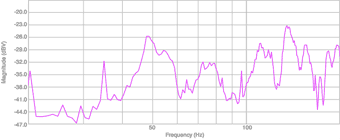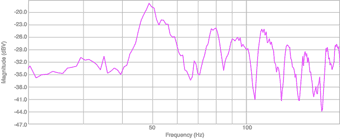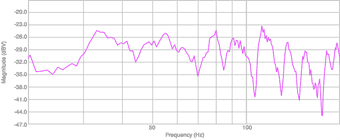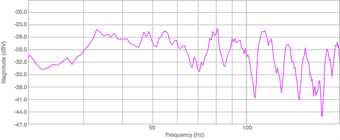Why multiple subwoofers in sound reproduction?
In an enclosed space sound is reflected by the room's boundaries. At certain frequencies, two or more reflected sound waves can superimpose themselves on one another in such a way where stationary locations can be found where that frequency becomes very loud or very quiet. This is called a mode.
In every enclosed space there's a certain frequency at which the sound field can be devided into two parts. This frequency is called the Schröder frequency. In common living rooms it's about 150–300 Hz.
At higher frequencies, above the Schröder frequency, modes are not a big problem because there are so many. Two ears and a brain are very good in suppressing modes that otherwise would lead to coloration of sound (see Bilsen). Music has a more transient nature at higher frequencies and other effects play a major role: Soundwaves need time to travel through the room (about 34.4 cm per millisecond). If the difference between the direct sound and reflected sound is bigger than about 1 ms then our brain is capable of separating the two. However, up to 30-80ms delay only one sound sensation is perceived (precedence effect). Later arriving reflections are perceived as an echo. If the difference is smaller than 1 ms then the two (or more) sounds are melted into one (summing localization).
At frequencies below the Schröder frequency, modes become a problem. Our hearing needs a couple of cycles before it can determine a sound's timbre but in acoustically small rooms reflections become part of the sound almost instantly because wavelengths are in the range of the room's dimensions (e.g. 40 Hz = 8.6 m wavelength). So what we hear is dominated by the room and not by the loudspeaker anymore.
At lower frequencies there are fewer modes and they are more spaced relative to each other. This commonly leads to the typical sensation of "booming" or "one-note" bass or even no bass at all at certain frequencies. In those cases the in-room frequency response shows stationary peaks (booming sound) and dips (no sound), an effect boosted by rigid walls. Contrary to common belief, angled walls or irregular floor plans do not reduce modes. They just change the modal distribution pattern within a room.
Additional low frequency sound sources distributed throughout the room can smooth out low frequency modal peaks and dips. Fortunately we can't localize sound sources below 80 Hz hence additional subwoofers can be used to smooth the frequency response at any given listening position or over a certain listening area. Studies have shown that only 2 to 4 subwoofers are necessary to significantly reduce seat-to-seat differences and increase frequency smoothness at low frequencies (see Welti/Devantier).
Subwoofer setup after Earl Geddes (GedLee LLC)
The multisub setup described on this page has two big advantages over other methods: only three subs are needed and you don't need to put the subwoofers at specified locations. Nonetheless there are some basic rules that have proven to yield best results:
Put one sub in a corner close to the mains. The second sub is a lot more flexible as to its location, but it should not be in a corner. Side wall or back wall, near the midpoint is a good idea. Put the third sub wherever you can that is not too close to the other two. It's a good idea to get one of them off of the floor.
Subwoofer requirements
Because we are using 3 subwoofers, they do not need to be as powerful as a single subwoofer. Any decent active subwoofer (ported or closed design) with a 10" or bigger driver will do. It should have controls for
- level (continuously variable)
- low pass frequency (continuously variable)
- phase (switchable or continuously variable)
- parametric equalizer (optional)
Measurement equipment
- Measurement microphone
- Microphone preamp
- Computer
- Realtime FFT analyzer software
- White noise signal (download - WAV, 5.1MB)
Calibration procedure
Make sure that the main loudspeakers are not high pass filtered as they act as additional low frequency sources, which is desirable.
"First setup the mains and the nearest sub [(the sub nearest to the mains)]. Set your spectrum analyzer to a very low bandwidth but not less than 200 Hz and fairly long averaging time. This will yield a very long average of the sound signal. Take your mic and move it through large spatial positions near but arround the prefered listening position. Be carefull as small bumps of the cable can generate large erroneous signals into the mic. The sweeping has to be smooth. When the analyzer has completed its run you will have a plot of the frequency and spatial averaged low frequency sound field. Try adjusting the sub - never adjust the mains - to see if you can get a better response by changing the gain, the low pass point, the phase and or delay if you have it. The bass should be sagging slightly at this point since you will be adding in two more subs.
Now add in the next closest sub and repeat the entire procedure again. You should be able to improve upon what you had before. If not try turning off the first sub and setting the second one optimal and then add in the first sub. If you still can't get a better response with two subs than with one then you will need to move one of them. You need to get an improvement from the second sub or something is wrong.
Now repeat this process with the third sub. The third sub, when you are close to it should barely be audible. If it is loud, then once again, something is wrong. It should only be filling in holes at this point and not adding any actual level. The level after two subs should be about flat or possibly a slight rise - based on preference. I find a few dB rise at the low end is desirable for best effect.
With the three subs things should be quite smooth when spatially averaged. You can now use any EQ that you have to make a final flattening of the response, but these bands should never be more than a few dB. When you are done, if things go as they usually do for me, your should have a spatial average of about ± 2-3 dB. This can take several hours so don't be impatient. [...] Make sure and write down all the settings!!
Two people helps - one to sweep the mic and another to run the analyzer. Sweep the mike vertically as well as horizontally, but in a wide ellipse. Its not necessary to repeat the same pattern, its only necessary to NOT leave the mic in a stationary position. You can try wider sweeps or narrower ones, but the bigger sweep will likely be better." (Earl Geddes)
Exemplary data
Mains only
First subwoofer added
Second subwoofer added
Third subwoofer added
Earl Geddes on low frequency reproduction
(See full interview at http://www.dagogo.com/View-Article.asp?hArticle=1047)
"[...] I did my Ph.D. thesis on the low frequency sound field in a small room, the frequency region that is dominated by discrete room modes. In that study I learned that all rooms are different in detail, but basically when one looked at them statistically they all act the same. This means that if one is trying to develop a uniform approach to good bass reproduction then they should look at the problem statistically.
A source in a room at low frequencies, any room, it doesn't matter, can be thought of as a random variable which is going to have peaks and dips in its response. There will always be a first mode response peak, which, as it turns out, is basically independent of the rooms shape and depends only on the room's volume. Then there will be a region with several discrete widely spaced modes and the response in this region will be quite ragged as a result of the very distinct nature of these individual modes. As the frequency goes up, the modal density gets greater and greater and the variations of the peaks and dips (the frequency variance – there is also a spatial or seat-to-seat variance as well) about the mean response will decrease to a constant value that becomes essentially independent of frequency, or room shape or size. (Although the transition point is dependent on the rooms size.)
One "radical" point of view that I took away from this work was that it is not "modes" that are a problem, it's the lack of modes that is the problem. It is simply not true that one does not want to excite the modes, one actually wants to excite as many modes as possible, which will result in a notably smoother response. This is quite different from (virtually the opposite of) the usual dogma in audio. Damping the low frequency modes causes them to spread and overlap more, which also reduces the variances in the response. But achieving high damping at these very low frequencies has to be done in the room's structure itself since no added damping material is going to have any significant effect. And it's important to keep this extra damping just at the lower frequencies because one does not want high room damping at the higher frequencies because that will destroy the spaciousness. High damping at low frequencies with low damping at high frequencies ends up being a fairly tough architectural problem.
Now, if we look at the room's low frequency response problem as one in which we have a single sample – a single source – of a statistically stable population (the sound field in both frequency and space), then from classic statistics we know that for each additional sample that we add to the result, the variance will drop by approximately 1/n where n is the total number of samples. Hence, if samples are sources, then we should expect that the variance of the sound field will also go as 1/n where n is the number of sources (subwoofers to us). This is in fact what happens (within some limits). The more subs that we have in a small room at low frequencies the smoother the response will become in both frequency and space. We can't really increase the number of modes, but we can easily increase the number of sources.
There are some limiting assumptions in the above and these are important. The most important limitation is that for the 1/n improvement to hold the samples/sources must each be independent of all the others (uncorrelated in statistical acoustics parlance). Two subs right next to each other are not independent, they are highly correlated. The farther the subs are from each other the less correlated they become. This means that we should start to add subs that are as widely spaced about the room as possible. However as you add more and more subs they have to get closer and closer together and hence the 1/n improvement will begin to vanish and it can be seen that the variance of the sound field can never be brought down to zero no matter how many subs we have. In fact, in practice I have found a significant improvement with the addition of a second sub, a smaller improvement when a third sub is added and the fourth sub usually shows only a small to negligible improvement. Beyond four subs is pretty much a waste of assets since the performance gains tend to zero (except for more headroom, of course)."



